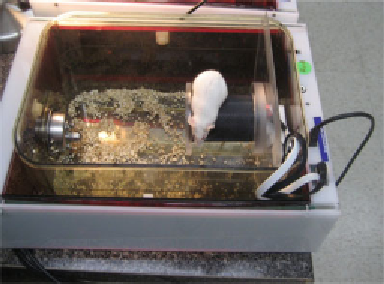Biology Reference
In-Depth Information
8
a
b
7
6
5
4
3
2
1
0
SHAM
MCAO
c
d
60
16
14
50
12
40
10
30
8
6
20
4
10
2
0
0
SHAM
MCAO
SHAM
MCAO
Fig. 6. Manual and spontaneous rotarod tests in home cage using SmartCage. (
a
) The photo shows the mouse stays on
rotating rod. (
b
) Duration staying on the rod was measured by manually placing the mouse on the rod. In this manual
rotarod test, MCAO mice at twenty-fourth hour after reperfusion had much shorter duration compared to and sham control
mice (
n
= 5 in each group,
p
< 0.002). (
c
) The same cohort of animals was tested on spontaneous rotarod performance in
the home cage for 30 min in 1 month after reperfusion. The MCAO mice had shorter mean duration compared to the sham
control mice, although they had improved the ability to stay on the rotating rod compared to that measured at twenty-fourth
hour following reperfusion. (
d
) The MCAO mice had a substantial reduction in spontaneous performance compared to the
sham group.
of natural recovery and drug treatment effects on the MCA occlusion
model and other neurological disorders (e.g., traumatic brain
injury or multiple sclerosis).
Light/dark preference test for evaluation of anxiety-like behavior in
the home cage
: Correlations have been found between ordinary
home cage activity and activity in a much larger chamber (e.g.,
open fi eld) in locomotion and anxiety-like behavior tests (
28
).
Therefore, we inserted a removable dark box (8 cm × 14 cm× 11 cm)
with an opening (4 cm × 4 cm) allowing the animal access in and
out of the box (Fig.
7a
). The IR matrix was used to automatically
detect light/dark place preference which serves as an anxiety-like
behavioral assay in the home cage. For this initial assessment, mice























































Search WWH ::

Custom Search